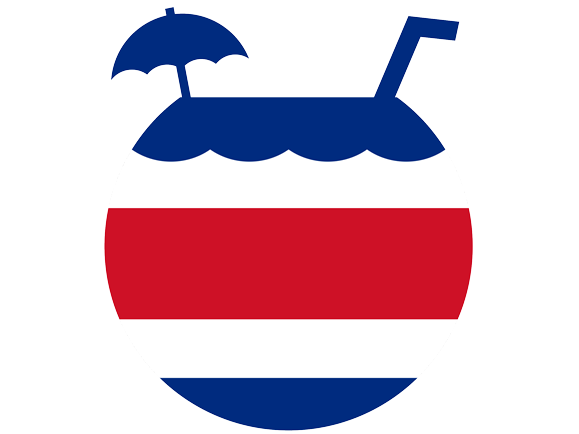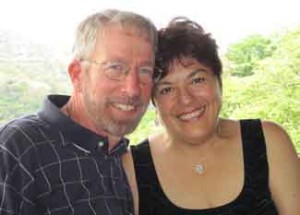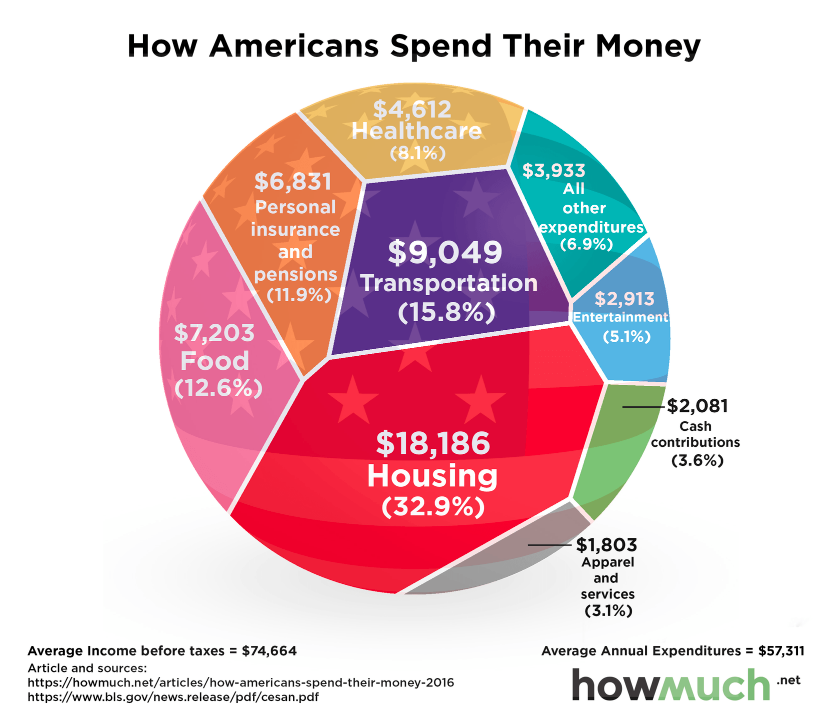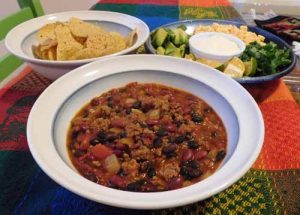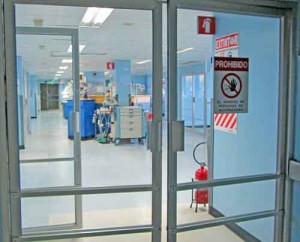Cost of Living, Life in CR
Retire for Less in Costa Rica – October 21, 2017
Welcome to our Retire For Less In Costa Rica Newsletter
In This Issue:
- Our Costa Rica Cost of Living, by Rob Evans
- In the Mailbag – End of Life Issues, Living Close to Nature, a Tour Memory, and Making the Move to Costa Rica
- Living the Expat Life
- Cooking in Costa Rica: An Expat’s Guide to Buying Groceries, Cooking, and Eating in Costa Rica
- Our Ultimate CR Healthcare Tour
Our Costa Rica Cost of Living, by Rob Evans
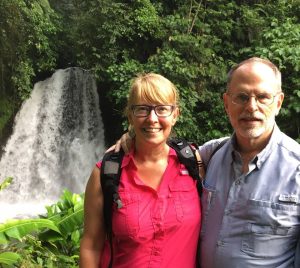 The Bureau of Labor Statistics’ annual report on consumer expenditures shows the “average” American household (AAHh) spent $57,311 in 2016. Note, $74,664 is the “average” income and $57,311 is the average spent after taxes.
The Bureau of Labor Statistics’ annual report on consumer expenditures shows the “average” American household (AAHh) spent $57,311 in 2016. Note, $74,664 is the “average” income and $57,311 is the average spent after taxes.
I decided to compare the expense published against what I spend in Costa Rica, but I see a problem with this right up front—undefined variables. For example, what is a “average” and what is “household”? A typical US household could include singles, married without children, married with many children, etc. And the “average” income is usually the “median” income since billionaires skew the income much higher than people could relate to. Furthermore, these averages are primarily for people still in the workforce, while my expenses are for a retired couple (50’s). So for the statisticians, I am afraid my comparison is not precise.
Still, the question of cost of living comes up frequently as working Americans nearing retirement wonder if they can afford to move to Costa Rica. On the forums, questions about cost of living receive answers ranging from $600 to $10,000 a month depending on whether the person answering is single or has a family, owns a home, lives on the beach, has a pool, uses AC, drinks alcohol, or owns multiple cars. Again, my answer is for a retired couple with no dependents, no car, no pets, and no pool, not living at the beach.
Comparison
Here is a side-by-side comparison of the published data and my costs. I spend about $2000 a month, which comes from my pension. I included the published average in the first column, the percent of the total in the second, my numbers in the third and fourth, and the percent difference in the last column. So, let’s explore each line item.
Housing
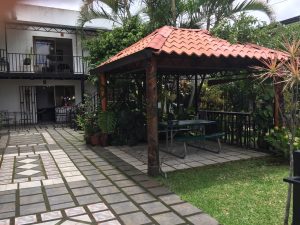 I rent a furnished, 2-bed, 1-bath home in the capital of San Jose. It is a convenient two-story, older apartment with lovely terraces and great security. The rent is $600, which includes water. We spent $700 a month in San Ramón all-inclusive so I know this amount of rent is not unusual. The electricity is about $50 a month and Internet is $30 (5Mb). We have a maid come by occasionally for $20, which is a common small luxury. You might see bigger numbers for electricity from some CR expats who have pools and rely on AC. The temperature in San Jose is a comfortable 75°F +/- 10 degrees, so we leave the windows open year-round. As a result, I spend 55% less than the average American household (AAHh). Again, be aware: many people will tell you their housing is $200 a month forgetting to mention they bought their home for $200k and have no mortgage or they rent unfurnished places (meaning they bought the stove/refrigerator, etc.).
I rent a furnished, 2-bed, 1-bath home in the capital of San Jose. It is a convenient two-story, older apartment with lovely terraces and great security. The rent is $600, which includes water. We spent $700 a month in San Ramón all-inclusive so I know this amount of rent is not unusual. The electricity is about $50 a month and Internet is $30 (5Mb). We have a maid come by occasionally for $20, which is a common small luxury. You might see bigger numbers for electricity from some CR expats who have pools and rely on AC. The temperature in San Jose is a comfortable 75°F +/- 10 degrees, so we leave the windows open year-round. As a result, I spend 55% less than the average American household (AAHh). Again, be aware: many people will tell you their housing is $200 a month forgetting to mention they bought their home for $200k and have no mortgage or they rent unfurnished places (meaning they bought the stove/refrigerator, etc.).
Transportation
I spend 93% less on transportation than the AAHh primarily because I do not own a car but walk and use the bus or Uber. One of the reasons I moved to CR was to lower my stress. I felt car ownership would cost more and cause more stress than it was worth. One benefit of walking was I lost 70 pounds. Again, note: what can be confusing about this category is that people will leave out the purchase price and depreciation costs for their car. They might include the gas, oil, taxes and maintenance, but leave out the $25k they spent to buy the car and the $2000 a year in depreciation as the car gets older.
Food
I spend 17% less on food than the AAHh. That is not a big difference and surprised me. This category includes both eating in and eating out. One difference is that the AAHh spends 40% of their budget eating out while I eat out infrequently. I have never worried much about our food budget but have concentrated more on making sure our food was healthy. I spend more on extravagances like salmon, which I think is good for us and spend less eating out. Again, note: since I am retired, I can spend more time shopping, preparing and cooking food than the AAHh who might need to pick up prepared food on the way home from work. Also, I drink very little alcohol, which can be a large “food budget” item for some.
Personal Insurance and Pension
I am not fully sure I understand all that is included in this category. As a retiree, I am not saving for retirement, so that is zero. For personal insurance, I spend $50/month for life insurance. I bought $100k term policy until I am 70 in the event I die before we collect Social Security. That should allow my wife to have the choice between staying in Costa Rica or moving back to the US. I do not have renters’ insurance.
Healthcare
Here’s a shocker. I spend 30% more than the AAHh. I broke down my healthcare costs in my previous article:
I spend about $300 a month on insurance and another $200 for deductible, tests, drugs, etc. or about $500 a month for two 60-year-old adults.
What you have to watch out for in this category are 1) number of people in the family; and 2) the actual cost and 3) flexibility.
I think the REAL cost of healthcare insurance in the US is about $500 per person per month for someone my age. So, $500 x 2 people x 12 months or $12k/yr. That is about what Medicare advertises for people who want Medicare but are not eligible from their work history. So, for comparison, it would cost me $500 x 2 people or $1000/month or $12,000/year for health insurance, which is one of the main reasons I needed to leave the US.
In addition, Americans have the cost of deductibles, co-payments, etc. that add more cost. Also, most Americans do not pay the actual bill. Employers often pay a portion of the employee’s health insurance up to the entire bill. I often hear people who pay nothing for health insurance confused on why people are complaining about the cost. In general, US employers pay 1/3 of the health insurance bill for employees. Once you leave the government or corporate world, you may be shocked to learn the ACTUAL cost. I suspect that the ACTUAL cost for the AAHh (employee + employer) is higher than reported with a supplement paid by the employer.
Finally, instead of health care, the US has pain management care—in other words, much of US healthcare cost is directed to fixing preventable problems. A subtle difference between the AAHh costs and my costs is that I try to direct resources to prevention and early detection. My priority is to stay out the hospital by investing in good nutrition, exercise, and preventive tests. When you pay your own way, you have that flexibility.
Entertainment
I spend 79% less on entertainment than the AAHh. Many Americans buy expensive cable TV packages, go to the movies, and attend professional and college sports. My needs are much simpler and I only have $8/month Netflix (one user / low definition) and go to the museum, buy a book, attend the theater and take in a movie infrequently. I want to note my income is higher than my expenses and I use that money for travel when ever the stock market is on the rise and stay home when it is not.
Cash Contribution
Cash contribution is primarily religious and political giving. Because of the election last year, political giving was way up. I left it zero because I think the amount is a personal matter.
Apparel and Services
I spend 83% less on this category than the AAHh. Since the weather is perfect in Costa Rica, there is no need for an abundance of clothing. In fact, we gave away all our winter clothes when we left the US. We even left a couple of final items in the hotel before our flight. I kept a sweater for when it gets down to 65°F. As for services, I guess they are referring to things like dry cleaning, duct cleaning, landscaping, gutter cleaning, etc., which do not pertain to me anymore. If they are referring to haircuts, those cost very little.
Conclusion
I hope this helps clarify the Cost of Living in Costa Rica question. It is a very important question for Americans trying to understand if they can retire in CR.
![]()
In the Mailbag – End of Life Issues, Living Close to Nature, a Tour Memory, and Making the Move to Costa Rica
 We always get lots of responses and questions from readers, both newsletter subscribers and on Facebook.
We always get lots of responses and questions from readers, both newsletter subscribers and on Facebook.
Folks particularly commented on the end of life articles in our last newsletter.
Bob B. wrote,
Gloria,
I wanted to thank you very much for addressing the ‘end of life’ information this month. I lost my wife of 48 years in December, and am working with a survivors support group now. I can tell you that no matter how much a couple or family thinks they have prepared, at the end, I at least was not prepared. I can not fully appreciate the additional difficulties that would be added by being in a different culture.
The ‘end of life’ has so many things coming at you like water out of a firehose. Bless you for trying to call some attention to the various possible items…It would probably be helpful if you could suggest several translators, I am thinking English to Spanish, (more specifically Costa Rican Spanish and medical terms, which often are not obvious, and a team member fluent in both Costa Rican Spanish/culture and medical terminology could be a huge assistance. I found that at the end things move fast, and you can’t call a time out!
Thanks, again, for bringing this forward.
Thanks, Bob, for your kind words. We appreciate it so much and are glad that you found our articles on end of life issues helpful. We will research Spanish/English translators and provide this information in an upcoming newsletter.
Regarding the body donation article, Marlene P. posted the following question on Facebook:
Excellent Information. If the paperwork us done for donation to medical, does the body stay in the home until death certicate is made? Does a private MD come to the home? How long would the body be in the home?
Judy Kerr, who wrote the article for us, responded:
When you sign up for body donation you are provided a card with multiple phone numbers on it to call at the time of death. The school will work with you in making this transition. A doctor must issue a death certificate for the deceased, then a team will come to transport the body to the medical school. This will happen as rapidly as possible, since any usable organs will be harvested for the living.
On another topic, Edie B. wrote,
Dear Paul and Gloria,
We have been reading your newsletters voraciously and taking in the advice Paul gave me on the phone…My question is, where is the wildlife? We have been studying climate, healthcare, culture, and all the other aspects of choosing one area over another in your newsletters gratefully but we have heard about people hearing monkeys outside their windows and hummingbirds and toucans in their gardens. Where are those places? Can you maybe do an article about that aspect of living in Costa Rica or a map? All the houses we have seen so far are pretty suburban. We would like to be on the edge of a Tico village near a town with amenities but still enjoy the rainforest. Have we set our sites to high? Thanks for the good work.
Hi Edie,
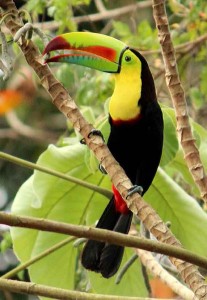 No, I don’t think you have set your sights too high. In fact, wildlife can be seen all over the country. not just in rural areas. When we lived about 10 minutes outside of the town of San Ramón, we had monkeys and toucans in the trees. When we lived at the Cabinas, also about 10 minutes outside of San Ramon, we saw an occasional sloth, lots of butterflies and birds, and even agoutis and coatis. Our friends in other towns like Grecia and San Isidro del General have had the same experiences. If you want monkeys, you would need to settle lower than 3,000 ft. elevation. Birds and butterflies are everywhere. You increase your chances of wildlife if you have some forest around you. But you don’t need to be way out in the country to enjoy the wildlife. As you explore different places to live, ask folks who live in those areas what wildlife can be seen there.
No, I don’t think you have set your sights too high. In fact, wildlife can be seen all over the country. not just in rural areas. When we lived about 10 minutes outside of the town of San Ramón, we had monkeys and toucans in the trees. When we lived at the Cabinas, also about 10 minutes outside of San Ramon, we saw an occasional sloth, lots of butterflies and birds, and even agoutis and coatis. Our friends in other towns like Grecia and San Isidro del General have had the same experiences. If you want monkeys, you would need to settle lower than 3,000 ft. elevation. Birds and butterflies are everywhere. You increase your chances of wildlife if you have some forest around you. But you don’t need to be way out in the country to enjoy the wildlife. As you explore different places to live, ask folks who live in those areas what wildlife can be seen there.
Hope this helps!
Gloria
Mike D. wrote to us about a tour he took with us,
This is Mike from Portland, Maine with whom you met 3 years ago on my visit with you to take part in a tour of San Ramón. I was there for tour of the Central Valley, but It was a week or so before Paul launched his medical tours and I think I was the “trial run” so too speak as I saw several clinics and hospitals. At one point Paul opened a door in the waiting room of a hospital and several patients looked up, saw these two gringos staring at them, well Paul started speaking in Spanish and within seconds he had those folks laughing as though he was Johnny Carson (does that show my age?) I really enjoyed my time with Paul that day, from the barbershop, to the local Red Cross office, to his car mechanic and his favorite little restaurant on the second floor of a building downtown San Ramon…I’m so happy for you guys following your dreams and living the life many others only wish they could have.
All the best too you both. Stay safe, stay healthy.
Mike D.
And finally, Linda R. wrote,
Hi. I want to thank you for your newsletter and let you know how helpful it has been for me. Several years back I started researching for a retirement destination for my husband and I. We did not want to stay in the States. Your newsletter helped with so much information that helped us. Two years ago we made our move here to Atenas. We couldn’t be more happy. Thank you for you dedication and time put into your newsletters.
Related Articles:
Living the Expat Life
Gloria and I moved to Costa Rica on April Fool’s Day of 2009. For the first three months, we stayed close to home, just trying to settle in and get our bearings. Our lives were full of changes. We moved into a small house for one month, then moved again into our present cabina. We bought a 1996 Toyota 4-Runner through a car buying service. We lost our beloved cat Cleo. We struggled to adjust to a new way of doing everything – communicating, cooking, socializing, working, and just daily living.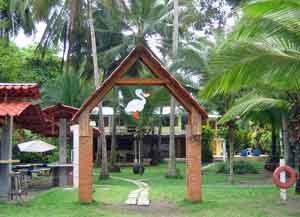
After those first three months, we took our first trip in our “new car.” It was a two hour drive. Our destination: the Pelican Hotel, directly on the Pacific Ocean. On that trip, I calmly asked my wife, Gloria,“How do you like being an expat?” I was slightly afraid of the answer as our first months had been fraught with challenges.
Her reply surprised me. “I love it!” she said. She explained to me how different it was to her from our previous life. She loved the experience. She loved stepping out of the box and testing herself.
 She told me she was fulfilling a life-long dream – when she was 20, she had planned to leave Baltimore for LA to work in the film business. At that time in her life, she chickened out. She was alone and just couldn’t do it. All these years she thought of what she didn’t do when she was 20 – the risk she didn’t take — and this was her opportunity to make up for that. This time, with her husband beside her, she wasn’t going to chicken out.
She told me she was fulfilling a life-long dream – when she was 20, she had planned to leave Baltimore for LA to work in the film business. At that time in her life, she chickened out. She was alone and just couldn’t do it. All these years she thought of what she didn’t do when she was 20 – the risk she didn’t take — and this was her opportunity to make up for that. This time, with her husband beside her, she wasn’t going to chicken out.
As I wrote this, I thought of an article written by Lee Harrison, Contributing Editor of International Living Magazine. On the last page of every issue, Lee always has “The Last Word.” In the March 2011 issue, his “last word” ended with the following:
And when you’re living abroad you’re someone special. To your overseas friends, you’re an adventurer…a worldly person who’s landed in their country. To your friends back home, you’re out there “living the dream.”
When you’re overseas, you’re part of an exclusive and well-connected “club” of expats and world travelers…and that feels good.
Most importantly – no matter how long you’ve been abroad – life is an adventure. You can spend years exploring your adopted country and culture…and if things start to feel routine, you can move on and experience the excitement all over again.
If I let that go, the adventure’s over. And with one life to live, I’m not ready for that. Arizona? Not for me.”
Lee pretty much summed up the way Gloria felt at that time over two years ago, and I’m happy to say that she still feels the same way today. And I do too.
![]()
Cooking in Costa Rica
I’m so excited to announce that my new book, Cooking in Costa Rica: An Expat’s Guide to Buying Groceries, Cooking, and Eating in Costa Rica is now available on Amazon.com! Here are a couple of my 5 star reviews:
Outstanding. I have been looking for a book that would tell me where to buy certain items that are not available in the local Costa Rica stores and I found all of that and more. Information such as translation from English to Spanish and of course Spanish to English. This is helpful so when I am shopping I can find what I am looking for using the translation. There is a break down of measurements and substitutions that was helpful. I like the few recipes that are included, and can’t wait to try them. This is a great book with so much information to help you learn about cooking in Costa Rica. I love the layout of the book and the clear explanations, and its easy to locate what I am looking for without going through an entire book. Also the resources in the back have been super helpful.. Thanks so much for the book.
Practical as well as scholarly, this is a must-have guide for any man or woman who commands a kitchen in Costa Rica. Wonderfully readable and quickly useable for whatever and whenever you may need to know all things culinary in Costa Rica. And if that were not enough, what an amazing tour guide for English-speaking lovers of food in a Spanish-speaking culture, where the recipes you know and have always loved can come alive in new and exciting ways. I just feel smarter having read it!
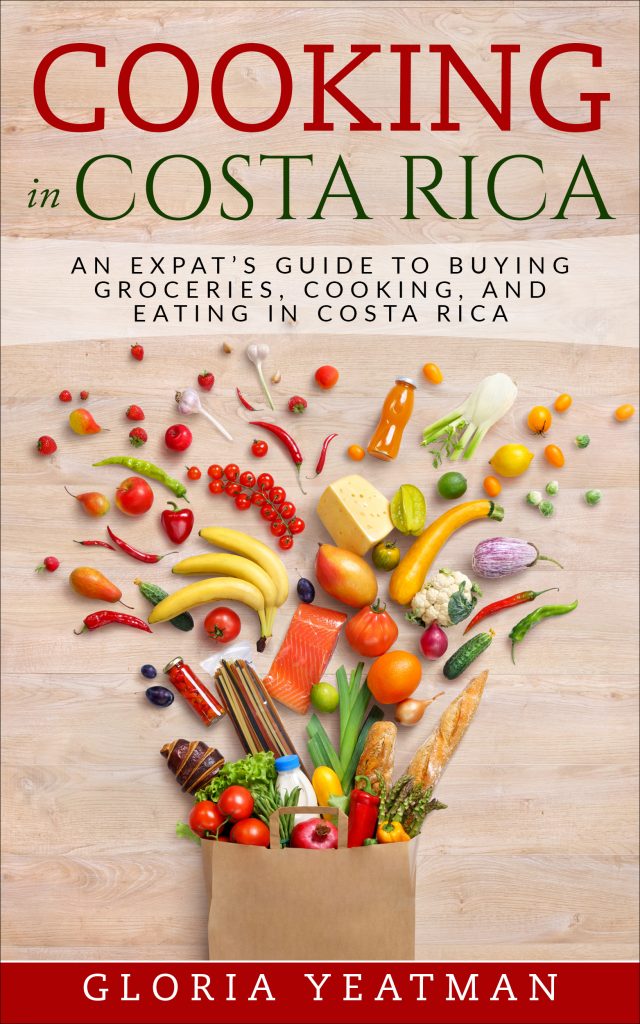 When you move to a Spanish-speaking country, it can be daunting to stock your kitchen and cook meals when you don’t know what your ingredients are called in Spanish. And even when you know the Spanish translation, it can be a challenge at times to find what you are looking for.
When you move to a Spanish-speaking country, it can be daunting to stock your kitchen and cook meals when you don’t know what your ingredients are called in Spanish. And even when you know the Spanish translation, it can be a challenge at times to find what you are looking for.
You can download this practical, comprehenive guide and on-going reference tool on your smart phone or iPad so you have it with you whenever you shop. The table of contents is interactive, so you can easily click through to the meat section when you are at the butcher shop (carnicería) or to the dairy section when you are standing in front of the dairy case. Here’s what you will find inside:
- A little bit about me, our life in Costa Rica, how and where we shop for groceries, what we spend, and some insights about grocery shopping in Costa Rica.
- An English-to-Spanish and Spanish-to-English food dictionary, broken down into the following sections:
- Fruits
- Vegetables
- Meat & Poultry
- Fish & Seafood
- Grains, Nuts, Seeds, & Baking Ingredients
- Dairy & Eggs, Refrigerated & Frozen Foods
- Beans, Canned & Prepared Foods
- Herbs, Spices, & Seasonings
- Condiments
- Beverages
- An English-to-Spanish and Spanish-to-English food dictionary in alphabetical order.
- An English-to-Spanish and Spanish-to-English dictionary of things you find in the kitchen.
- A Glossary of cooking terms and helpful adjectives to use when buying and cooking food, ordering in a restaurant, and reading recipes in Spanish.
- Recipe substitutions for when you can’t find familiar ingredients here in Costa
Rica.
- Recipes which I have adapted to use with ingredients found in Costa Rica, plus some favorite recipes of other expat cooks in Costa Rica.
- A U.S. Measure to Metric Conversion Guide for temperature, volume, weight, and length.
- A resource section with links to expat cooking blogs, Facebook groups and pages, specialty products, and other food-related things.
The Kindle version is available now on Amazon.com. If you don’t have a Kindle, you can download the Kindle app for your iPad or computer at this link. A print version is in the works; I will let you know as soon as it is published. In the meantime, you can buy the Kindle version through this link:
I hope you enjoy my book and find it useful!
Gloria
![]()
Our Ultimate CR Healthcare Tour
We are proud to offer the Ultimate Healthcare Tour of Costa Rica. When asked what he liked best about our healthcare tour, one of our guests wrote, “the wide variety of places we saw, the experts that Paul  arranged for us to meet and talk with, and an emphasis on all aspects of health, not just doctors and hospitals. Mental health is just as important as physical, if not more so.”
arranged for us to meet and talk with, and an emphasis on all aspects of health, not just doctors and hospitals. Mental health is just as important as physical, if not more so.”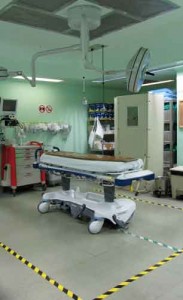
We’ve lived in Costa Rica for over eight years and have used the Caja, Costa Rica’s public healthcare system extensively, as well as the private system, when needed. We’ve learned the system and have been referred up the ladder to see specialists in the maze that is the Caja system. Gloria’s even had surgery here.
Our blend of personal insights and on-the-ground experience combines to answer your questions about whether or not Costa Rica’s healthcare system could meet your individual needs.
But, while it is focused on healthcare, you will learn a lot more about living and retiring in Costa Rica’s Central Valley. Most of the second day of the tour takes place in the town of San Ramón where we live and use the services. And you will come to our home that day to listen to two presentations.
Our tour is designed to save you both time and money, packing a lot of information into a short period of time. Our goal is to show you the possibilities and to try to demystify Costa Rica’s healthcare system. Our tour lasts two days and 1 night and includes lodging, transportation, meals and non-alcoholic beverages.
Sample Itinerary
You’ll visit:
- At least two private hospitals in San Jose area
- Hospital Mexico, the largest and best public hospital (they even do open heart surgeries there)
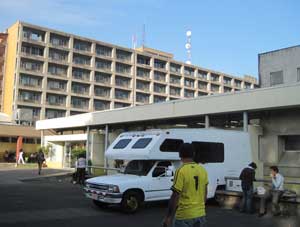
- An insurance broker for a presentation on the various supplemental health insurance options, including public, private, and international plans
- A senior living retirement community
- CPI language school for a presentation about how learning Spanish increases your options for healthcare and some basic medical Spanish.
- Our local hospital here in San Ramón
- A local EBAIS (community clinic)
- The office of our dentist in San Ramón
- A local Seguro Social office where you would sign up for the Caja (national healthcare coverage)
- A pharmacy
- A local feria (farmer’s market) where you will see the abundance of fresh food available.
- The local Cruz Roja (Red Cross) to learn about their services and programs.
- A health food store (macrobiotica), and more!
You’ll learn:
- If the Costa Rican healthcare system could meet your needs and put your mind to rest, once and for all, about this sensitive subject.
- About the public system and how it works, about the private healthcare system, and how you can use a combination of both to your advantage.
- About the EBAIS – where healthcare starts in Costa Rica.
- Approximately how much you would pay for Caja.
- About medical tourism in Costa Rica.
- About home health care in Costa Rica.
Prices: $650 for a couple, $550 for a single.
Please contact us if you are interested in booking a tour. Space is limited.
Related Articles:
- Paul Gets a CAT Scan Through the Caja
- Integration 102 – Speaking Up at the Hospital
- Waiting to See the Doctor, by Jo Stuart
 Facebook, Twitter, & YouTube
Facebook, Twitter, & YouTube
![]()
![]()
![]() You can now follow us on Facebook and Twitter, so please “like” us on Facebook, “follow” us on Twitter, and watch and share our videos on YouTube.
You can now follow us on Facebook and Twitter, so please “like” us on Facebook, “follow” us on Twitter, and watch and share our videos on YouTube.
 What’s New on the Website
What’s New on the Website
Check out our newest posts on www.retireforlessincostarica.com:
- End of life Issues – Burial and Cremation in Costa Rica
- End of Life Issues – Body Donation in Costa Rica, by Judy Kerr
- Searching the World for the Best Place to Retire: One Couple’s Criteria
- Our August 2017 Costa Rica Cost of Living
- Banking in Costa Rica: Our Experience, by Rob Evans
- Paul & Gloria in Mexico: Oaxaca’s Guelaguetza Extravaganza
- Our July 2017 Costa Rica Cost of Living
- Our June 2017 Costa Rica Cost of Living
- My 2017 Healthcare Plan, by Rob Evans
- Paul’s Money Saving Tip: Find Reasonably Priced Housing
- Our 2016 Annual Cost of Living in Costa Rica Summary
- In the Mailbag – Vonage, and Getting an Emergency U.S. Passport
- Con Mucho Gusto: The Tico Way
